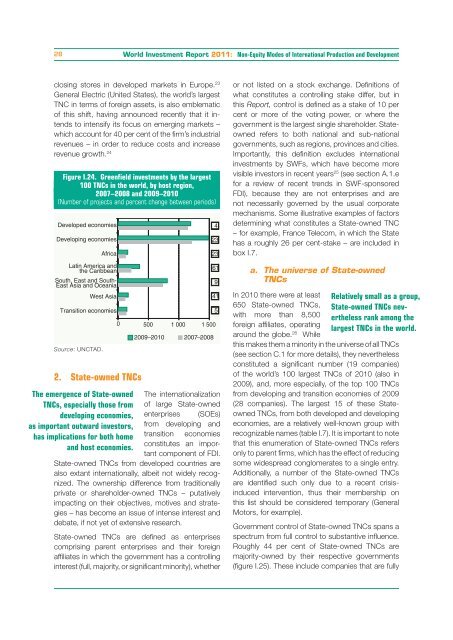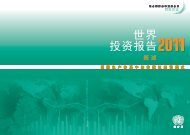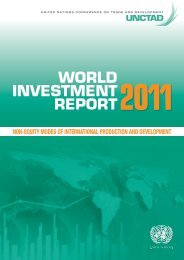CHAPTER I Global Investment Trends
CHAPTER I Global Investment Trends
CHAPTER I Global Investment Trends
You also want an ePaper? Increase the reach of your titles
YUMPU automatically turns print PDFs into web optimized ePapers that Google loves.
28<br />
World <strong>Investment</strong> Report 2011: Non-Equity Modes of International Production and Development<br />
closing stores in developed markets in Europe. 23<br />
General Electric (United States), the world’s largest<br />
TNC in terms of foreign assets, is also emblematic<br />
of this shift, having announced recently that it intends<br />
to intensify its focus on emerging markets –<br />
which account for 40 per cent of the firm’s industrial<br />
revenues – in order to reduce costs and increase<br />
revenue growth. 24<br />
Figure I.24. Greenfield investments by the largest<br />
100 TNCs in the world, by host region,<br />
2007–2008 and 2009–2010<br />
(Number of projects and percent change between periods)<br />
Developed economies<br />
Developing economies<br />
Latin America and<br />
the Caribbean<br />
South, East and South-<br />
East Asia and Oceania<br />
Transition economies<br />
Source: UNCTAD.<br />
Africa<br />
West Asia<br />
2. State-owned TNCs<br />
The emergence of State-owned<br />
TNCs, especially those from<br />
developing economies,<br />
as important outward investors,<br />
has implications for both home<br />
and host economies.<br />
0 500 1 000 1 500<br />
2009–2010 2007–2008<br />
4<br />
23<br />
23<br />
61<br />
9<br />
41<br />
The internationalization<br />
of large State-owned<br />
enterprises (SOEs)<br />
from developing and<br />
transition economies<br />
constitutes an important<br />
component of FDI.<br />
State-owned TNCs from developed countries are<br />
also extant internationally, albeit not widely recognized.<br />
The ownership difference from traditionally<br />
private or shareholder-owned TNCs – putatively<br />
impacting on their objectives, motives and strategies<br />
– has become an issue of intense interest and<br />
debate, if not yet of extensive research.<br />
State-owned TNCs are defined as enterprises<br />
comprising parent enterprises and their foreign<br />
affiliates in which the government has a controlling<br />
interest (full, majority, or significant minority), whether<br />
5<br />
or not listed on a stock exchange. Definitions of<br />
what constitutes a controlling stake differ, but in<br />
this Report, control is defined as a stake of 10 per<br />
cent or more of the voting power, or where the<br />
government is the largest single shareholder. Stateowned<br />
refers to both national and sub-national<br />
governments, such as regions, provinces and cities.<br />
Importantly, this definition excludes international<br />
investments by SWFs, which have become more<br />
visible investors in recent years 25 (see section A.1.e<br />
for a review of recent trends in SWF-sponsored<br />
FDI), because they are not enterprises and are<br />
not necessarily governed by the usual corporate<br />
mechanisms. Some illustrative examples of factors<br />
determining what constitutes a State-owned TNC<br />
– for example, France Telecom, in which the State<br />
has a roughly 26 per cent-stake – are included in<br />
box I.7.<br />
a. The universe of State-owned<br />
TNCs<br />
In 2010 there were at least<br />
650 State-owned TNCs,<br />
with more than 8,500<br />
foreign affiliates, operating<br />
around the globe. 26 Relatively small as a group,<br />
State-owned TNCs nevertheless<br />
rank among the<br />
largest TNCs in the world.<br />
While<br />
this makes them a minority in the universe of all TNCs<br />
(see section C.1 for more details), they nevertheless<br />
constituted a significant number (19 companies)<br />
of the world’s 100 largest TNCs of 2010 (also in<br />
2009), and, more especially, of the top 100 TNCs<br />
from developing and transition economies of 2009<br />
(28 companies). The largest 15 of these Stateowned<br />
TNCs, from both developed and developing<br />
economies, are a relatively well-known group with<br />
recognizable names (table I.7). It is important to note<br />
that this enumeration of State-owned TNCs refers<br />
only to parent firms, which has the effect of reducing<br />
some widespread conglomerates to a single entry.<br />
Additionally, a number of the State-owned TNCs<br />
are identified such only due to a recent crisisinduced<br />
intervention, thus their membership on<br />
this list should be considered temporary (General<br />
Motors, for example).<br />
Government control of State-owned TNCs spans a<br />
spectrum from full control to substantive influence.<br />
Roughly 44 per cent of State-owned TNCs are<br />
majority-owned by their respective governments<br />
(figure I.25). These include companies that are fully








